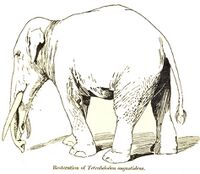
FAIR is a non-profit organization dedicated to providing well-documented answers to criticisms of the doctrine, practice, and history of The Church of Jesus Christ of Latter-day Saints.
To see citations to the critical sources for these claims, [[../CriticalSources|click here]]
John L. Sorenson:
The only place that elephants are mentioned in the Book of Mormon is in Ether 9:19 in approximately 2500 B.C. Thus any elephants existing upon the American continents need not have survived past about 2400 B.C...Besides the traditions, five elephant effigies have been found in ancient Mexico. Dr. Verrill, a well-known (non-Mormon) archaeologist describes one of these figures as “‘so strikingly and obviously elephantine that it cannot be explained away by any of the ordinary theories of being a conventionalized or exaggerated tapir, ant-eater or macaw. Not only does this figure show a trunk, but in addition it has the big leaf-like ears and the forward-bending knees peculiar to the elephants. Moreover, it shows a load or burden strapped upon its back. It is inconceivable that any man could have imagined a creature with the flapping ears and peculiar hind knees of an elephant, or that any human being could have conventionalized a tapir to this extent’”...
The oral traditions, written records, and artwork depicting elephants lends strong support for the claim that the elephant existed in ancient America. Even more substantial support-- actual remains-- have also been discovered. Today all scholars agree that mastodons and mammoths (which are unquestionably elephants to zoologists) once lived in the Americas. The dispute today is how late they lived. According to the Book of Mormon they need not have lived later than 2400 B.C. Within recent years archaeological evidence has demonstrated that the elephant could very well have survived to such a late date. Butchered mastodon bones were recently discovered at one archaeological site which dates to shortly after the time of Christ. Another site, dating to approximately 100 B.C. has yielded the remains of a mammoth, a mastodon, as well as a horse.[1]

A lesser-known type of elephant-like creature also existed from 12 million years ago. These were the Gomphotheres:
Wikipedia notes that "the last two South American species, in the genus Cuvieronius, did not finally become extinct until possibly as recently as 9,100 BP, and Stegomastodon remains have been dated as recently as 6,060 BP in the Valle del Magdalena, Colombia." [3] The term "BP" means "Before Present" and is defined to be the year 1950. Therefore 6060 BP would be approximately 4110 BC. Any elephants mentioned in the Book of Mormon need not have survived past about 2400 B.C. This leaves a gap of approximately 1700 years.
Wikipedia also notes:
Gomphothere remains are common at South American Paleo-indian sites.[2] One example is the early human settlement at Monte Verde, Chile, dating to approximately 14,000 years ago.
Gomphotheres differed from elephants in their tooth structure, particularly the chewing surfaces on the molar teeth. Most had four tusks, and their retracted facial and nasal bones prompt paleontologists to believe that gomphotheres had elephant-like trunks.[4]
Recently, archaeologists from the University of Arizona discovered Gomphotheres bones which showed evidence of having been hunted by humans in North America 13,400 years ago. Prior to this it was believed that they had died out prior to the arrival of humans in North America.
Gomphotheres were smaller than mammoths -- about the same size as modern elephants. They once were widespread in North America, but until now they seemed to have disappeared from the continent's fossil record long before humans arrived in North America, which happened some 13,000 to 13,500 years ago, during the late Ice Age.
However, the bones that Holliday and his colleagues uncovered date back 13,400 years, making them the last known gomphotheres in North America. [5]
The Marshall Illustrated Encyclopedia of Dinosaurs and Prehistoric Animals states that they "probably died out as recently as AD 400".
We do not usually associate the South American Continent with elephants. However, remains of Cuvieronius have been found in mountainous areas of Norrh and South Arnerica, a fact reflected in its synonym Cordillerion - 'the one from the mountain range'. Cuvieronius evolved in western North America at the end of the Miocene, and migrated to South America during Pleistocene times, around 2 Million years ago. It spread from the grassy pampas in the east to the heights of the Andes in the west:, reaching as far south as Argentina. It was hunted to extinction, and probably died out as recently as AD 400.” [6]
In short, the elephant presents no problem for the Book of Mormon.
<videoflash>BgzVaU6F1e4</videoflash>

FAIR is a non-profit organization dedicated to providing well-documented answers to criticisms of the doctrine, practice, and history of The Church of Jesus Christ of Latter-day Saints.
We are a volunteer organization. We invite you to give back.
Donate Now